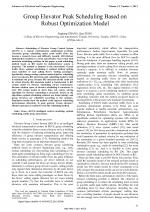| 3/2013 - 9 |
Group Elevator Peak Scheduling Based on Robust Optimization ModelZHANG, J. |
| Extra paper information in |
| Click to see author's profile in |
| Download PDF |
Author keywords
EGCS, intelligent control, modeling, optimal scheduling, traffic peak, uncertainty
References keywords
elevator(16), control(16), group(11), systems(10), optimization(10), system(7), scheduling(6), robust(6), research(5), method(5)
Blue keywords are present in both the references section and the paper title.
About this article
Date of Publication: 2013-08-31
Volume 13, Issue 3, Year 2013, On page(s): 51 - 58
ISSN: 1582-7445, e-ISSN: 1844-7600
Digital Object Identifier: 10.4316/AECE.2013.03009
Web of Science Accession Number: 000326321600009
SCOPUS ID: 84884920267
Abstract
Scheduling of Elevator Group Control System (EGCS) is a typical combinatorial optimization problem. Uncertain group scheduling under peak traffic flows has become a research focus and difficulty recently. RO (Robust Optimization) method is a novel and effective way to deal with uncertain scheduling problem. In this paper, a peak scheduling method based on RO model for multi-elevator system is proposed. The method is immune to the uncertainty of peak traffic flows, optimal scheduling is realized without getting exact numbers of each calling floor's waiting passengers. Specifically, energy-saving oriented multi-objective scheduling price is proposed, RO uncertain peak scheduling model is built to minimize the price. Because RO uncertain model could not be solved directly, RO uncertain model is transformed to RO certain model by elevator scheduling robust counterparts. Because solution space of elevator scheduling is enormous, to solve RO certain model in short time, ant colony solving algorithm for elevator scheduling is proposed. Based on the algorithm, optimal scheduling solutions are found quickly, and group elevators are scheduled according to the solutions. Simulation results show the method could improve scheduling performances effectively in peak pattern. Group elevators' efficient operation is realized by the RO scheduling method. |
| References | | | Cited By |
Web of Science® Times Cited: 1 [View]
View record in Web of Science® [View]
View Related Records® [View]
Updated 3 weeks, 2 days ago
SCOPUS® Times Cited: 2
View record in SCOPUS® [Free preview]
View citations in SCOPUS® [Free preview]
There are no citing papers in the CrossRef Cited-by Linking system.
Disclaimer: All information displayed above was retrieved by using remote connections to respective databases. For the best user experience, we update all data by using background processes, and use caches in order to reduce the load on the servers we retrieve the information from. As we have no control on the availability of the database servers and sometimes the Internet connectivity may be affected, we do not guarantee the information is correct or complete. For the most accurate data, please always consult the database sites directly. Some external links require authentication or an institutional subscription.
Web of Science® is a registered trademark of Clarivate Analytics, Scopus® is a registered trademark of Elsevier B.V., other product names, company names, brand names, trademarks and logos are the property of their respective owners.
Faculty of Electrical Engineering and Computer Science
Stefan cel Mare University of Suceava, Romania
All rights reserved: Advances in Electrical and Computer Engineering is a registered trademark of the Stefan cel Mare University of Suceava. No part of this publication may be reproduced, stored in a retrieval system, photocopied, recorded or archived, without the written permission from the Editor. When authors submit their papers for publication, they agree that the copyright for their article be transferred to the Faculty of Electrical Engineering and Computer Science, Stefan cel Mare University of Suceava, Romania, if and only if the articles are accepted for publication. The copyright covers the exclusive rights to reproduce and distribute the article, including reprints and translations.
Permission for other use: The copyright owner's consent does not extend to copying for general distribution, for promotion, for creating new works, or for resale. Specific written permission must be obtained from the Editor for such copying. Direct linking to files hosted on this website is strictly prohibited.
Disclaimer: Whilst every effort is made by the publishers and editorial board to see that no inaccurate or misleading data, opinions or statements appear in this journal, they wish to make it clear that all information and opinions formulated in the articles, as well as linguistic accuracy, are the sole responsibility of the author.



